Will you be going on holiday to… Greenland next year?
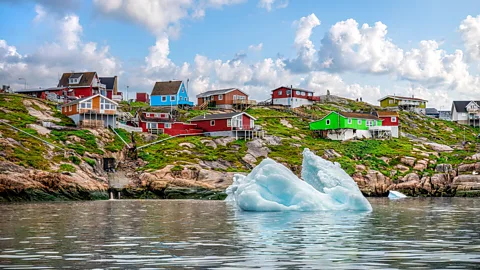 Getty Images
Getty ImagesGreenland is about to open up to adventure-seeking visitors. How many tourists will come is yet to be seen, but the three new airports will bring profound change.
Greenland's capital is a tiny city with big plans. Large aircraft will soon be able to touch down here after the new Nuuk International Airport officially opens on 28 November. There'll be direct flights from Copenhagen, and, by June, twice weekly connections from New York. It's the first of three airport projects – costing more than $800m (£615m) – intended to fling this Arctic territory wide open to travellers.
Spanning more than two million square kilometres, the world's largest island exists on a scale so vast it's hard to conceive. Only 11 countries are bigger – and it surpasses both Texas and Alaska in size – yet its population numbers fewer than 57,000. At its frozen heart is an ice sheet that covers 80% of its land mass.
When I visited in August from Copenhagen, the ground crunched beneath my boots as I made my way over rocky glacial moraine onto the edge of this endless icy expanse that stretched beyond the misty horizon. Both mighty and magical, it was a humbling reminder of the awesomeness of nature.
Hours earlier, I'd touched down at Kangerlussuag Airport. Up until now, the remote cluster of prefabricated buildings in Greenland's desolate, wild west has been the country's main entry point, and most international visitors will have landed here. Built during World War Two, the former American airbase is one of the country's few airstrips long enough for jet planes. Greenland's mountainous and ice-bound topography means there are no roads between settlements; instead, there's a network of small airstrips and heliports. From Kangerlussuaq, visitors have had to transit to their onward destination in small propeller aircraft, just as I did to Nuuk.
But that will now change.
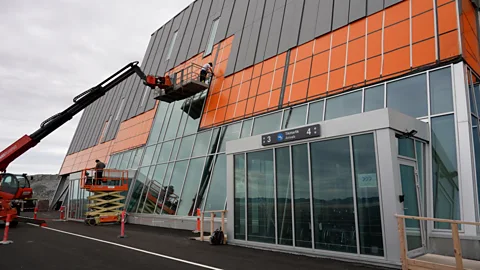
Nuuk's new international airport means that getting to Greenland will become simpler, faster and cheaper. The city sits roughly four hours from the US and four hours from Europe. "We're placed right in the middle. So there's great opportunities to grow tourism from both sides," said Jens Lauridsen, CEO of Greenland Airports. "We're seeing an increasing interest from North American tourists at the moment."
Thoughtful Travel
Want to travel better? Thoughtful Travel is a series on the ways people behave while away, from ethics to etiquette and more.
Another transatlantic airport will open in Ilulissat in 2026, the country's most popular destination and a launchpad for exploring the towering icebergs of Disko Bay and the Unesco-recognised Icefjord. This will be followed that same year by a brand-new regional airport in Qaqortoq, the largest settlement in the south and arguably Greenland's most picture-perfect town, where pink, blue and green houses tumble from the steep hillside down to the harbour.
Across Europe, several destinations have been pushing back against tourism. But Greenland stands out because it is actively seeking more visitors. The nation is hoping to bolster its economy, which relies largely on fishing, by diversifying into tourism. Greenland's attractions are many, from spectacular raw nature to the unique culture of the Inuit. In the summer, there's whale-watching and splendid hiking, while dark winters bring dog sledding and the spellbinding Northern Lights.
How many tourists will come is unknown. But according to Lauridsen, between April and August this year, the inbound seat capacity to Greenland was 55,000; by next summer, that will jump to 105,000 for the same period. Air Greenland will operate daily flights between Nuuk and Copenhagen in planes carrying 300-plus passengers. Then in June, SAS will also begin flying from the Danish capital, and United will launch direct flights from New York. "Many people have been to London, Paris and Rome. They're looking for more experiences and looking for outdoors, particularly post-Covid," said United's vice president, Patrick Quayle. "We're planning on starting small just because there has never been this type of service."
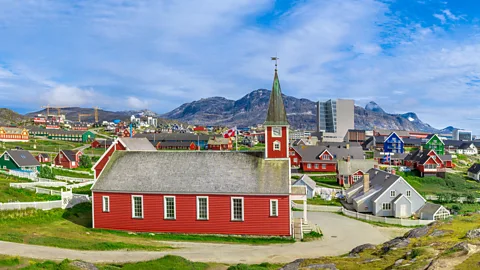 Getty Images
Getty ImagesWith roughly 20,000 residents, Greenland's capital is certainly no metropolis. Made up of high-rise apartment blocks and colourful cottages, it's wedged between rugged mountains and a sweeping sea fjord on the country's south-west coast. It's a modern town where 21st-Century life blends with Inuit roots, and is home to a fascinating and informative national museum, a thought-provoking art gallery and a cutting-edge cultural centre with musical performances.
However, it's the nature on Nuuk's doorstep that offers some of the most rewarding experiences. Visitors can rent kayaks to explore the capital's historic waterfront or venture deeper into the vast Nuuk Fjord for whale-watching and fishing trips. On land, there are easy day hikes from the city and more adventurous multi-day guided walks; not to mention remote glamping sites where you can get even further away from it all.
When I finally arrived in Nuuk, I felt a sense of optimism in the air, with local businesses eagerly awaiting the new airport. Aningo Broberg and his wife Pia, run a family-owned tour company, Sumut Greenland, near Nuuk's small harbour, which they launched earlier this year. "Actually the new airport is 80% of the reason why we took the plunge," Aningo told me. After a strong first season taking tourists on excursions around Nuuk Fjord, including sunset sailing trips and more adventurous tours up close to icebergs, the pair plan to buy a second boat. "We are expecting more [tourists] will come."
I briefly chatted to tourists at the colonial harbour along Nuuk's historic waterfront. "The Arctic was on our bucket list," said Kelly from Florida, who had sailed here from Iceland by cruise ship. "It was something different."
"I've never been in Greenland. That's why I've come here. It's quiet, not many people. I like that," added Mary, another cruise ship passenger, from Taiwan.
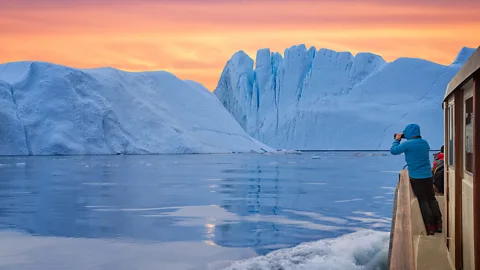 Getty Images
Getty ImagesThat desire to holiday off the beaten path has already translated into a small tourism boom. Record numbers of visitors – some 141,000 – came to Greenland last year, much of it driven by cruise ship tourism that saw passenger volumes surge by a whopping 74%. With the new airports, that's only expected to grow.
"We get more and more guests from all over the world," said Maren-Louise Poulsen Christiansen, the manager of Inuk Hostels, as she showed me around the glass igloos at her guesthouse that overlooks a scenic bay on Nuuk Fjord with views of the dramatic Sermitsiaq mountain.
She told me people are excited and are preparing for the influx of new visitors. "One of the worries I have is that we will have too few rooms [in Nuuk]," she added. "We also need more local guides and locals working in tourism."
More like this:
• The summer that tourism fell apart
• Are you really helping when you join an 'expedition tour'?
• Europe wants you to travel by train. But why is it so complex and expensive?
Several new hotel projects are reportedly in planning, but analysis by tourist board Visit Greenland suggests both Nuuk and Ilulissat could face a shortage of accommodation. That may well limit visitors, which is why Air Greenland's chief executive, Jacob Nitter Sorensen, believes there won't be explosive growth. "I think it's going to be a bit organic in the beginning," he said.
"There's a lot of positivism towards [tourism] growth and what it can do for Greenland but [only] if it's done right," emphasises Stine Selmer, an independent sustainable tourism consultant. How much locals actually want tourism depends on who you speak to, she adds. Indeed, frequent crowds of tourists in popular places such as Ilulissat and Qaqortoq have caused frustration among some locals.
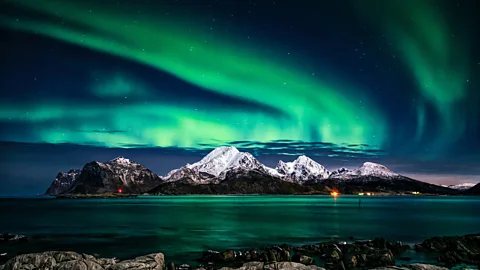 Getty Images
Getty ImagesGreenland's wow-factor comes from its untouched nature and uncrowded spaces. "There is really a maximum we can carry without ruining our destination and the products that we're selling," says Selmer. "It's this peace and quiet, sort of an under-the-radar destination, and I think we kind of want to keep that."
Most Greenlanders seem to agree that mass tourism isn't desirable, or sustainable, and Greenland doesn't want to be the next Iceland, a country of 384,000 people that saw 2.2 million visitors last year. "When we look around the world, we sense that people are very happy to be able to travel again post pandemic," said business minister Naaja Nathanielsen, "but we also see people getting weary of tourists."
Instead, the nation is seeking more thoughtful growth that benefits local communities. Last year the tourism industry adopted a pledge "towards better tourism", and it's trying to attract conscious adventure travellers who value pristine nature and deeper cultural experiences, while encouraging them to come outside the peak summer period and spend time in less crowded places. Marketing campaigns emphasise winter and shoulder season activities like dog-sledding and aurora watching; while Visit Greenland's website, for example, points potential visitors to smaller destinations around Disko Bay, rather than hotspot Ilulissat.
Meanwhile, a much-debated tourism law will come into force in January 2025 requiring tour companies to be licensed and two-thirds locally owned. It will also introduce a traffic-light system of red, orange and green zones, and levy a tax of 30 kroner (£3.35) per night per visitor. "We're trying to both use zoning as an instrument to spread the tourists out more, and to make sure they don't go in certain areas that are more vulnerable," said Nathanielsen.
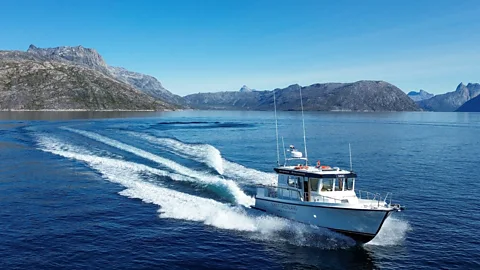 Sumuk
SumukLying 150km north of the capital, Maniitsoq is a less-visited smaller town that also hopes to benefit. Small motorboats make the four-hour voyage there by weaving through a maze of low-lying rocky islands and stopping in the tiniest of villages as locals hop on and off.
Sitting below a striking mountain range, Maniitsoq's colourful, weather-beaten buildings straddle a rocky outcrop along the coast. Rather fancifully nicknamed the "Venice of Greenland", there's a handful of bridges that crisscross the harbour and a striking arch made from a whale's jawbone that overlooks the sea. In summer it draws fishing enthusiasts, and ski-touring groups in winter. It's also a jumping off point for hikes to the astonishing Inussuit Tasersuat, a turquoise body of water lying beneath jagged grey peaks, dubbed "The Great Lake of Giants" in English; and for boat trips to the breathtaking Eternity Fjord, where blue-hued glaciers calve ice into the sea.
"There's a lot to sell in our area. We have so many fjords, so many beautiful places," said Ole Zeeb Skifte, the owner of Maniitsoq Adventure Tours, which runs hiking and fishing tours. The closure of the local fish factory a decade ago saw people move away, he added. But now hopes are high again. "I'm so excited about the new airport," Skifte told me. "I just [hope] that more young people will get into tourism and start a business."
--
If you liked this story, sign up for The Essential List newsletter – a handpicked selection of features, videos and can't-miss news, delivered to your inbox twice a week.
